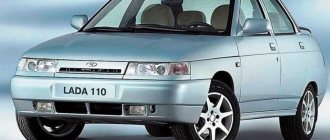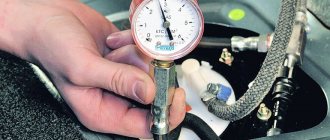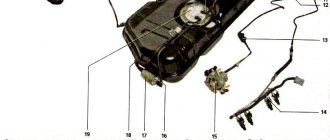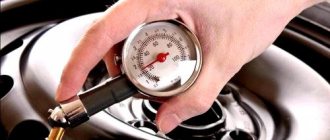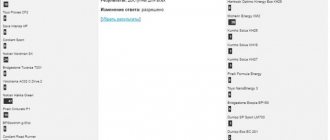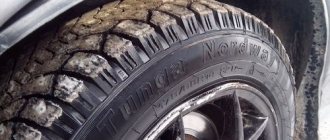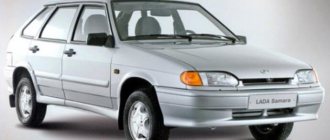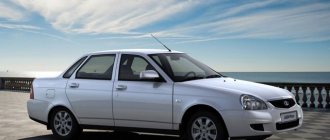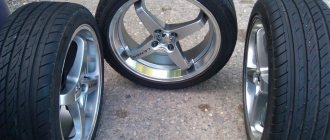When operating the car without a full load, it is recommended to inflate the tire pressure of the VAZ 2114 to 1.9 atm in the summer. When the car moves with a large number of passengers and cargo, the inflation rate in the wheels increases to 2.0. This applies to any season. In winter, the pressurization of the slopes in a warm room should be carried out 0.2 atmospheres above normal. In frosty weather, the pumping will decrease by this amount.
Correct pressure in Lada tires allows the driver to get rid of a number of troubles. When driving on lowered wheels, it is more difficult to control the car, the stability of the car is reduced, the steering wheel is difficult to turn and the tread wears out more.
If the tires are overinflated, the load on the front suspension increases, the slopes wear unevenly and there is a possibility of a sharp rupture.
WHAT IS THE RISK OF DEVIATION FROM THE SET PARAMETERS
Front-wheel drive cars of the Volzhsky Automobile Plant, such as the VAZ 2110, VAZ 2114 and VAZ 2115, can be equipped with wheels with a radius of R13, R14, R15 and R16, but the standard cars are equipped only with rims and tires of the 13th and 14th radius. The optimal tire pressure depends primarily on the load and weight of the vehicle; much also depends on road conditions and ambient temperature.
If the wheels are poorly inflated, then:
- The tire tread will wear out faster;
- It will become more difficult to control the car and turn the steering wheel harder;
- Fuel consumption will increase, and the more flat the tires, the more noticeable the gasoline consumption;
- The car will become prone to skidding, especially on wet and snowy roads, and stability will be lost;
- The power of the car will decrease as the resistance to movement will increase.
If the wheels are inflated more than normal, then this is also not very good:
- When driving, you can feel all the unevenness of the road surface and the ride becomes uncomfortable. In addition, the chassis wears out faster;
- Due to less grip on the road surface, the braking distance is longer, which has a detrimental effect on traffic safety;
- The tire tread wears unevenly, and the service life of the tires is noticeably reduced;
- A hernia may appear on the wheel, and under high pressure when hitting an obstacle, the rubber may rupture, which is completely unsafe at high speed.
Below are three pictures that show how the rubber tread adheres to the road at optimal, low and excess pressure.
Many car owners are wondering what pressure should be in R14 tires on VAZ models. According to technical conditions, the wheels on a VAZ 2114 (2115) car are inflated to 1.9 kgf/cm² (R13), on VAZ 2110-2112 cars it is recommended 2.0 kgf/cm² (R14). Moreover, it makes no difference what axle the wheels are on - front or rear.
The essence of the test
To find out what tire pressure should be in order to save fuel and have a comfortable ride, experts conducted a test on a Lada 112 with Kleber Viaxer summer tires installed. There were 2 passengers in the cabin, the trunk was empty.
| Criteria | Underinflated summer tires (1.5 atm) | Overinflated summer tires (2.5 atm) | Standard (2.0 atm) |
| Wear | along the edges | in the center | the manufacturer guarantees the longest possible service life |
| Gasoline consumption (relative to standard) | +2% | -1,6% | |
| Coasting from 80 km/h | 1108 m | 1232 m | 1176 m |
| Maximum speed at “rearrangement” | 61 km/h | 87 km/h | 66 km/h |
| Length of the brake path at the limit value of wheel locking on a dry surface | 44 m | 45.9 m | 45 m |
| Controllability (course stability, smooth ride) | highly smooth ride, almost complete lack of sensitivity to surface unevenness (9 points out of 10); decrease in directional stability (7 points out of 10) | increased directional stability (8 points out of 10); decrease in ride smoothness - you can feel all the patches and bumps (6 points out of 10) | normal stability on the road surface, control over the course. (8 points out of 10) |
Thus, tire pressure in warm and cold seasons affects the technical characteristics of the car (in this case, Lada 112). Its correct indicators ensure optimal fuel consumption and savings on the purchase of new tires.
INFLUENCE OF WEATHER CONDITIONS AND ROAD FACTORS
The pressure in VAZ tires in summer should, in principle, be the same as in winter. But in practice in winter it is made a little lower for a number of reasons:
- Slightly lower tires allow you to better control the car on slippery roads, it becomes more stable;
- The suspension is made softer, and road unevenness is less felt;
- The braking distance becomes shorter, reducing the likelihood of an emergency.
It is necessary to take into account the fact that after a temperature change (after leaving a warm garage on a frosty street), the pressure in the R14 tires will become less due to physical factors. Therefore, you should check it before you hit the road and, if necessary, pump up the tires. Also, when it gets warmer after winter, pressure measurements should be taken.
The pressure in R13 tires in summer is usually maintained at 1.9 atm, but this level is designed for an average vehicle load (two or three people in the cabin). If the car is fully loaded, then the pressure should be increased on the front axle to 2.0-2.1 atm., on the rear axle to 2.3-2.4 atm. The spare wheel is inflated to 2.3 atm.
Russian roads are not of good quality, and therefore many car owners deliberately lower the tire pressure somewhat so that all the unevenness of the road surface is not so noticeably felt when driving. Typically, in summer the wheels are lowered by 5-10%, and in winter by 10-15% of the norm. On flat roads you can stick to the factory standard.
For example, a table of car tire pressures:
For example, a table of car tire pressures
Review of the best summer and winter tires
Using tires that suit the seasons will save fuel and make driving more comfortable. The best choice for summer driving would be the Toyo Nano Energy 3. This version of the wheel is characterized by a relatively low noise level and fuel efficiency. However, on wet roads the braking distance is relatively long.
Yokohama Bluearth AE01 will cost relatively inexpensively - about 3 thousand rubles for 1 cylinder. In this case, the composition of the mixture includes rubber and some other components that make the rubber soft.
Michelin Energy XM2 tires are one of the most economical and durable modifications. They are distinguished by their durable sidewall and excellent grip properties. The manufacturer provides a 5-year warranty. Like the model discussed above, handling on wet roads leaves much to be desired.
Nokian Hakka Green 2 tires, thanks to their unique tread design, provide driving comfort and save fuel. The manufacturer provides a lifetime warranty for this model.
Continental ContiEcoContact 3 was specially developed by the manufacturer for compact cars. The use of such tires will significantly reduce the braking distance, regardless of the type of road surface. The tire contains silicon dioxide. It provides excellent grip on the road.
Nokian Hakkapeliitta R2 SUV is a relatively expensive tire for driving in winter. The aggressive symmetrical pattern and a large number of slats make the machine as stable as possible. The cost of 1 cylinder is from 6 thousand rubles.
Nexen Winguard winSpike SUV WS6 175/65 R14C are tires manufactured in South Korea equipped with 250 steel studs. Easily support up to 600 kg per wheel. Cost – from 4,000 per 1 piece.
Sailun Endure WSL1 175/65 R14C is perfectly balanced and removes water well from the contact patch with the road. However, it is worth noting the absence of spikes - this point does not have the best effect on handling in winter.
GT Radial Icepro 3 175/65 can easily withstand loads of up to 530 kg per wheel. Speed index T – up to 190 km/h. Reliable tires at a relatively low cost.
Roadstone Eurovis Alpine WH1 185/60 – non-studded winter tires. Designed for travel speeds up to 190 km/h. The cost is only 2,800 rubles. Which is an excellent solution for car owners on a limited budget.
Properly selected tires are the key to safe movement on the road. Nominal pressure and properly selected wheels ensure safety on the road.
LARGER DIAMETER WHEELS
From the factory, the installation of wheels with diameters R15 and R16 is not provided, but some car enthusiasts, in pursuit of fashion and improved technical characteristics, install them on their VAZs. And accordingly, you need to know what the pressure should be in the R15 tires, and what the pressure should be in the R16 tires. It all depends on the workload of the VAZ model. With an average vehicle load, the wheels are inflated to 2 kgf/cm²; on a loaded car, it is better to inflate them to 2.2 kgf/cm². And if there is a lot of heavy luggage in the trunk, then the rear tires are pumped up by another 0.2 kgf/cm². It turns out that the pressure in R14 tires is approximately the same as the pressure in R15 and R16 tires (for VAZ 2110-2115 models).
What about VAZ?
The optimal pressure in the tires of a VAZ 2107 will differ from the pressure in the tires of a VAZ 2114 or any other car. This is due to the fact that each car has its own weight and wheel size. In addition, operating conditions and other factors must be taken into account. That is, everything matters: time of year, climate zone, load, etc.
In order to inflate the wheels as correctly as possible, this is especially important in winter, you need to look at the vehicle’s operating instructions. There is information about what wheels need to be installed on the car and what air pressure should be in them for normal driving.
It is also worth paying attention to tires; as a rule, they have extremely permissible pressure values on their sidewalls.
In VAZ cars, most rims have a radius of 13, which is designated R13, but the tires need to be inflated differently.
METHODS OF MEASUREMENT
How to measure the tire pressure of VAZ cars? The measurement can be made using a special dial pressure gauge, but it should be noted that they may have an error of 0.2 atm. The pressure gauge can be either a separate device or as part of a wheel inflation pump.
We measure the pressure very simply:
- Reset the pressure gauge readings to zero;
- Remove the cap from the wheel spool (if there is one);
- Place the pressure gauge fitting on the nipple and press;
- We look at the arrow reading on the device.
It is recommended to take measurements at least once a month if the machine is used regularly. It is recommended to check tire inflation before leaving the garage after a long stay.
Pressure may increase when tires heat up. This often happens if the driver prefers a dynamic driving style with frequent and sharp braking. Therefore, measurements are taken on the car before the trip, when the wheels have not yet warmed up.
TIRES INJECTION WITH NITROGEN
Recently, it has become fashionable to inflate wheels not just with air, but with nitrogen.
There is an opinion that:
- Nitrogen keeps pressure more stable, and when the wheel heats up, it does not change in the tires;
- Rubber does not age longer because the pumped air with nitrogen is cleaner;
- A steel wheel rim rusts less;
- The likelihood of rubber rupture is reduced, since nitrogen does not support combustion and reduces the risk of explosion.
But it seems that all the claims about nitrogen are just a publicity stunt. The air is already almost 80% nitrogen, and if its content inside the tire increases to 95%, little will change for the better.
Therefore, it is hardly worth giving in to the persuasion of sellers of dubious services and throwing money away. The only thing you can be sure of is that the wheels will not get worse from pumping nitrogen. If you don't mind the money, then you can try this innovation on your car.
What should the tire pressure be?
The manufacturer of both the car and the tires always recommends maintaining a certain tire pressure, and the tire pressure on both the front and rear axles does not necessarily have to be the same. It all depends on the load on the car, weight distribution, and weather conditions.
If the wheel has high pressure, then:
- The resistance coefficient decreases.
- Less susceptible to deformation.
- The point of contact with the road is reduced.
- Low shock absorption.
- High controllability.
If the tire has low pressure:
- The point of contact with the road increases.
- The resistance coefficient increases.
- Consumption increases.
- More comfort on uneven roads.
- Low controllability.
The tire consists of 2 main parts: Tread and sidewall. The protector is a dense material that is not very susceptible to deformation. The sidewall, on the contrary, suffers greatly from both low and high pressure.
At low pressure, it is possible that the rim of the disk will cut through the tire on a bump or hole, and you, at best, will not be able to continue driving on such a “wheel.” And with high pressure, upon impact, a hernia may pop out or simply burst. But we are talking about pressure 2 to 3 times higher than normal; if you overinflated the tire by 10-15%, then there is nothing catastrophic about it.
When you need to lower your tires a little
In some cases, there are recommendations to slightly lower the tire pressure than specified in the recommendations. There are two such cases:
- In winter, if the pressure is a little less, then better traction occurs. But as the temperature changes, the internal volume in the tire also changes.
- The most popular use for slightly lowered wheels is off-road driving. In this case, the wheels will act on the principle of tracks. Which will increase cross-country ability.
But it is difficult for an inexperienced driver to determine by what indicators to reduce the pressure. Therefore, we do not recommend experimenting.
Conclusion: the pressure in car tires must be checked regularly, maintained at the level recommended by the manufacturer, and weather and road conditions taken into account. This will extend their life and help make your ride safer.
Many owners of VAZ 2114 cars ask the question: “what pressure should be in the tires?” According to the manufacturer's recommendation, this indicator must correspond to a certain value. At the same time, on a VAZ 2114 car, the pressure in the tires of the front and rear axles may not be the same. This depends on the weight distribution, the load on the machine and the climatic conditions. If the pressure in the VAZ 2114 tires is higher than the nominal value, then they are less deformed, the drag coefficient and the point of contact with the road surface are reduced, high controllability and low shock absorption are observed. If the indicator in the wheel is low, then contact with the road and the drag coefficient increase, consumption increases, low controllability is observed, but greater comfort on uneven surfaces. The tire consists of a sidewall and tread. The protector is made of dense matter, which is little subject to deformation. And the sidewall suffers due to exceeding or decreasing this indicator. For example, in low pressure conditions on a hole or bump, the disc rim can cut the tire, and if it is exceeded, the wheel can burst or herniate. But if the tire was overinflated by 10-15%, exceeding the standard by 2-3 times, then a disaster will not occur. Many people ask the question: what pressure should be in the tires of a VAZ 2114 with a radius of r13. The car manufacturer advises setting its level around 1.9 kgf/cm², but you can set it to 2 kgf/cm². To accurately determine this indicator, you can use the formula in the table. For tires with a radius of r14 and r15, it is recommended to set about 2 kgf/cm². To determine exactly what tire pressure should be, the formula in the table is also used. Setting the parameter in tires does not depend on their size and radius, it depends on the load. Therefore, it will be approximately the same for all tire radii.
What should be the air pressure in the tires?
r13
The VAZ manufacturer recommends setting the tire pressure at 1.9 (kgf/cm2). You can also set it to 2 (kgf/cm2). For a more accurate determination of pressure, look at the formula in the table.
r14
The manufacturer recommends setting the pressure at 2 (kgf/cm2). For a more accurate determination of pressure, look at the formula in the table.
r15
Setting tire pressure does not depend on the radius and size of the tire, but depends on the load. Therefore, the values for all radii are approximately the same. The manufacturer recommends setting the pressure at 2 (kgf/cm2).
For a more accurate determination of pressure, look at the formula in the table.
Car tire pressure table
How and how to measure tire pressure?
There are two main ways to measure tire pressure:
- Using a pressure gauge.
- Using a pump with a pressure gauge.
In both cases you need to do the same operations:
- Remove the cap (if equipped).
- Remove the cap or spool on the nipple.
- Release the pressure on the pressure gauge using the button.
- Place the pressure gauge or pump onto the nipple.
- Let's look at the readings.
Each pressure gauge has an error of 0.2 bar.
How to measure blood pressure
In cars such as the VAZ 2107 or VAZ 2114, of course, there are no automatic monitoring systems already installed at the factory. Therefore, the driver must take care of himself.
Gas pressure gauge for measuring tire pressure
There are several types of devices that allow you to monitor tire pressure. They have different capabilities, which accordingly affects the cost and ease of use.
- For those who infinitely value their lives and safety for them - this is not just a word, there are special tire pressure monitoring systems. Their installation is not easy and the cost is high, but there are a lot of positive qualities. They allow you not only to perfectly inflate your tires, but also to monitor any changes in pressure, which makes it possible to promptly eliminate all shortcomings and problems.
- Various types of pressure gauges: mechanical, electronic, should always be in the arsenal of any driver. Each type has its pros and cons, as well as a significant difference in cost.
- The most primitive devices are cap devices. They don't show exact numbers, but their color scale will indicate whether the tire pressure is normal or not.
What tire pressure is allowed for VAZ 2114
| Model | Tire size | Tire pressure MPa (kgf/cm2) | |
| front wheels | rear wheels | ||
| VAZ 2104 | 165/80R13 | 1.6 | 2,1 |
| 175/70R13 | 1,6 | 2,2 | |
| VAZ 2105 | 165/80R13 | 1.6 | 1,9 |
| 175/70R13 | 1,7 | 2,0 | |
| VAZ 2106 | 165/80R13 | 1,6 | 1,9 |
| 175/70R13 | 1,7 | 2,0 | |
| 165/70R13 | 1,8 | 2,1 | |
| VAZ 2107 | 165/80R13 | 1,6 | 1,9 |
| 175/70R13 | 1,7 | 2,0 | |
| VAZ 2108/09/99 | 165/70R13 | 1,9 | 1,9 |
| 175/70R13 | 1,9 | 1,9 | |
| 155/80R13 | 1,9 | 1,9 | |
| VAZ 2115 | 165/70R13 | 1,9 | 1,9 |
| 175/70R13 | 1,9 | 1,9 | |
| VAZ 2110/11/12 | 175/70R13 | 1,9 | 1,9 |
| 175/65R14 | 2,0 | 2,0 | |
| 185/60R14 | 2,0 | 2,0 | |
| VAZ 1118 Kalina | 175/70R13 | 1,9 | 1,9 |
| 185/60R14 | 1,9 | 1,9 | |
Table of permissible tire pressures for VAZ (Lada) passenger cars
| Model | Modifications | Recommended tire size | Recommended tire pressure | |||||||
| No load in summer | With load in summer | No load in winter | With load in winter | |||||||
| Front | Rear | Front | Rear | Front | Rear | Front | Rear | |||
| 2101 | 2101 1.2 (58 hp) | 155 SR13 | 1.6 | 1.6 | 1.6 | 1.7 | 1.5 | |||
| 2101 | 21011 1.3 (70 hp) | 165/70 SR13 | 1.6 | 1.6 | 1.6 | 1.7 | 1.5 | 1.5 | 1.5 | 1.6 |
| 2101 | 21013 1.2 (64 hp) | 155 SR13 | 1.6 | 1.6 | 1.6 | 1.7 | 1.5 | 1.5 | 1.5 | 1.6 |
| 2102 | 2102 1.2 (58 hp) | 155 SR13 | 1.6 | 1.6 | 1.6 | 1.7 | 1.5 | 1.5 | 1.5 | 1.6 |
| 2102 | 21021 1.3 (64 hp) | 155 SR13 | 1.6 | 1.6 | 1.6 | 1.7 | 1.5 | 1.5 | 1.5 | 1.6 |
| 2103 | 2103 1.5 (72 hp) | 175/70 SR13 | 1.9 | 1.9 | 1.9 | 1.9 | 1.8 | 1.8 | 1.8 | 1.8 |
| 2103 | 21033 1.3 (64 hp) | 175/70 SR13 | 1.9 | 1.9 | 1.9 | 1.9 | 1.8 | 1.8 | 1.8 | 1.8 |
| 2104 | 2104 1.3 (64 hp) | 175/70 SR13 | 1.6 | 2.2 | 1.6 | 2.3 | 1.5 | 2.1 | 1.5 | 2.2 |
| 2104 | 21043 1.5 (70 hp) | 165/70 R13 | 1.6 | 2.1 | 1.6 | 2.2 | 1.5 | 2 | 1.5 | 2.1 |
| 2104 | 21045 1.5 D (50 hp) | 175/65 R13 | 1.6 | 2.2 | 1.6 | 2.3 | 1.5 | 2.1 | 1.5 | 2.2 |
| 2104 | 21047 1.7 i (79 hp) | 165 SR 13 | 1.6 | 2.1 | 1.6 | 2.2 | 1.5 | 2 | 1.5 | 2.1 |
| 2104 | 21048 1.8 D (64 hp) | 175/60 R13 | 1.6 | 2.2 | 1.6 | 2.3 | 1.5 | 2.1 | 1.5 | 2.2 |
| 2105 | 2105 1.3 (64 hp) | 175/70 SR13 | 1.9 | 1.9 | 1.9 | 2 | 1.8 | 1.8 | 1.8 | 1.9 |
| 2105 | 21051 1.2 (59 hp) | 175/50 R13 | 1.9 | 1.9 | 1.9 | 2 | 1.8 | 1.8 | 1.8 | 1.9 |
| 2105 | 21053 1.5 (68 hp) | 165/65 R13 | 2 | 2 | 2 | 2 | 1.9 | 1.9 | 1.9 | 1.9 |
| 2106 | 2106 1.6 (75 hp) | 175/50 R16 | 2 | 2 | 2 | 2 | 1.9 | 1.9 | 1.9 | 1.9 |
| 2106 | 21061 1.5 (71 hp) | 175/50 R13 | 2 | 2 | 2 | 2 | 1.9 | 1.9 | 1.9 | 1.9 |
| 2106 | 21063 1.3 (64 hp) | 175/70 R13 | 1.9 | 1.9 | 1.9 | 1.9 | 1.8 | 1.8 | 1.8 | 1.8 |
| 2106 | 21065 1.5 (71 hp) | 175/50 R13 | 2 | 2 | 2 | 2 | 1.9 | 1.9 | 1.9 | 1.9 |
| 2106 | 1.5 i (56 kW) | 165/70 R 13 79 T | 2 | 2 | 2 | 2 | 1.9 | 1.9 | 1.9 | 1.9 |
| 2106 | 1.5 i (56 kW) | 175/70 R 13 82 T | 1.9 | 1.9 | 1.9 | 1.9 | 1.8 | 1.8 | 1.8 | 1.8 |
| 2106 | 1.5 i (56 kW) | 185/60 R 14 82 T | 1.9 | 1.9 | 1.9 | 1.9 | 1.8 | 1.8 | 1.8 | 1.8 |
| 2107 | 2107 1.5 (71 hp) | 175/70 SR13 | 1.9 | 1.9 | 2 | 2 | 1.8 | 1.8 | 1.9 | 1.9 |
| 2107 | 21072 1.3 (64 hp) | 175/50 R13 | 2 | 2 | 2 | 2 | 1.9 | 1.9 | 1.9 | 1.9 |
| 2107 | 21073 1.7 (76 hp) | 165/55 R14 | 1.9 | 1.9 | 2 | 2 | 1.8 | 1.8 | 1.9 | 1.9 |
| 2107 | 21074 1.6 (74 hp) | 165/65 R13 | 2 | 2 | 2 | 2 | 1.9 | 1.9 | 1.9 | 1.9 |
| 2107 | 1.5 i (56 kW) | 165/70 R 13 79 T | 2 | 2 | 2 | 2 | 1.9 | 1.9 | 1.9 | 1.9 |
| 2107 | 1.5 i (56 kW) | 175/70 R 13 82 T | 1.9 | 1.9 | 1.9 | 1.9 | 1.8 | 1.8 | 1.8 | 1.8 |
| 2107 | 1.5 i (56 kW) | 185/60 R 14 82 T | 1.9 | 1.9 | 1.9 | 1.9 | 1.8 | 1.8 | 1.8 | 1.8 |
| 2108 | 2108 1.3 (64 hp) | 165/70 SR13 | 2 | 2 | 2 | 2 | 1.9 | 1.9 | 1.9 | 1.9 |
| 2108 | 21081 1.1 (54 hp) | 165/70 R13 S | 2 | 2 | 2 | 2 | 1.9 | 1.9 | 1.9 | 1.9 |
| 2108 | 21083 1.5 (80 hp) | 175/60 R13 | 2 | 2 | 2 | 2 | 1.9 | 1.9 | 1.9 | 1.9 |
| 2108 | 1.5 i (56 kW) | 165/70 R 13 79 T | 2 | 2 | 2 | 2 | 1.9 | 1.9 | 1.9 | 1.9 |
| 2108 | 1.5 i (56 kW) | 175/70 R 13 82 T | 1.9 | 1.9 | 1.9 | 1.9 | 1.8 | 1.8 | 1.8 | 1.8 |
| 2108 | 1.5 i (56 kW) | 185/60 R 14 82 T | 1.9 | 1.9 | 1.9 | 1.9 | 1.8 | 1.8 | 1.8 | 1.8 |
| 2109 | 2109 1.3 (64 hp) | 165/70 SR13 | 2 | 2 | 2 | 2 | 1.9 | 1.9 | 1.9 | 1.9 |
| 2109 | 21091 1.1 (54 hp) | 165/55 R14 | 2 | 2 | 2 | 2 | 1.9 | 1.9 | 1.9 | 1.9 |
| 2109 | 21093 1.5 (76 hp) | 165/55 R14 | 1.9 | 1.9 | 1.9 | 1.9 | 1.8 | 1.8 | 1.8 | 1.8 |
| 2109 | 1.5 i (56 kW) | 165/70 R 13 79 T | 2 | 2 | 2 | 2 | 1.9 | 1.9 | 1.9 | 1.9 |
| 2109 | 1.5 i (56 kW) | 175/70 R 13 82 T | 1.9 | 1.9 | 1.9 | 1.9 | 1.8 | 1.8 | 1.8 | 1.8 |
| 2109 | 1.5 i (56 kW) | 185/60 R 14 82 T | 1.9 | 1.9 | 1.9 | 1.9 | 1.8 | 1.8 | 1.8 | 1.8 |
| 21099 | 21099 1.5 (70 hp) | 175/50 R13 | 1.9 | 1.9 | 1.9 | 1.9 | 1.8 | 1.8 | 1.8 | 1.8 |
| 21099 | 21099 1.5i (76 hp) | 175/60 R13 | 1.9 | 1.9 | 1.9 | 1.9 | 1.8 | 1.8 | 1.8 | 1.8 |
| 21099 | 210993 1.3 (64 hp) | 175/50 R13 | 1.9 | 1.9 | 1.9 | 1.9 | 1.8 | 1.8 | 1.8 | 1.8 |
| 21099 | 210994 1.6i (80 hp) | 175/60 R13 | 1.9 | 1.9 | 1.9 | 1.9 | 1.8 | 1.8 | 1.8 | 1.8 |
| 2110 | 21100 1.5 (69 hp) | 175/70 SR13 | 1.9 | 1.9 | 1.9 | 1.9 | 1.8 | 1.8 | 1.8 | 1.8 |
| 2110 | 21101 1.6i (80 hp) | 175/50 R13 | 2 | 2 | 2 | 2 | 1.9 | 1.9 | 1.9 | 1.9 |
| 2110 | 21102 1.5 8v (79 hp) | 175/50 R13 | 2 | 2 | 2 | 2 | 1.9 | 1.9 | 1.9 | 1.9 |
| 2110 | 21103 1.5 16v (94 hp) | 175/50 R14 | 2 | 2 | 2 | 2 | 1.9 | 1.9 | 1.9 | 1.9 |
| 2110 | 21104 1.6 16v (89 hp) | 175/65 R14 | 2 | 2 | 2 | 2 | 1.9 | 1.9 | 1.9 | 1.9 |
| 2110 | 21106 2.0 16v GTI (148 hp) | 195 65/R15 | 2.2 | 2.2 | 2.2 | 2.2 | 2.1 | 2.1 | 2.1 | 2.1 |
| 2111 | 2111 1.5 8v (79 hp) | 175/65 R14 | 1.9 | 1.9 | 1.9 | 1.9 | 1.8 | 1.8 | 1.8 | 1.8 |
| 2111 | 21111 1.5 (72 hp) | 175/70 R13 | 1.9 | 1.9 | 1.9 | 1.9 | 1.8 | 1.8 | 1.8 | 1.8 |
| 2111 | 21112 1.6 8v (80 hp) | 175/50 R13 | 1.9 | 1.9 | 1.9 | 1.9 | 1.8 | 1.8 | 1.8 | 1.8 |
| 2111 | 21113 1.5 16v (89 hp) | 175/60 R14 | 1.9 | 1.9 | 1.9 | 1.9 | 1.8 | 1.8 | 1.8 | 1.8 |
| 2111 | 21114 1.6 16v (90 hp) | 175/60 R14 | 2 | 2 | 2 | 2 | 1.9 | 1.9 | 1.9 | 1.9 |
| 2111 | 2111-90 (Tarzan) 1.8 (85 hp) | 205/70 R15 | 2.4 | 2.4 | 2.4 | 2.4 | 2.3 | 2.3 | 2.3 | 2.3 |
| 2112 | 2112 1.5 16v (94 hp) | 175/65 R14 | 1.9 | 1.9 | 1.9 | 1.9 | 1.8 | 1.8 | 1.8 | 1.8 |
| 2112 | 21121 1.6 (75 hp) | 175/55 R15 | 1.9 | 1.9 | 1.9 | 1.9 | 1.8 | 1.8 | 1.8 | 1.8 |
| 2112 | 21122 1.5 (76 hp) | 175/60 R14 | 2 | 2 | 2 | 2 | 1.9 | 1.9 | 1.9 | 1.9 |
| 2113 | 2113 1.5 (79 hp) | 165/70 R13 | 1.9 | 1.9 | 1.9 | 1.9 | 1.8 | 1.8 | 1.8 | 1.8 |
| 2113 | 21134 1.6 (81 hp) | 175/50 R13 | 2 | 2 | 2 | 2 | 1.9 | 1.9 | 1.9 | 1.9 |
| 2114 | 2114 1.5 (77 hp) | 165/70 R13 | 1.9 | 1.9 | 1.9 | 1.9 | 1.8 | 1.8 | 1.8 | 1.8 |
| 2114 | 21144 1.6 (81 hp) | 175/50 R13 | 2 | 2 | 2 | 2 | 1.9 | 1.9 | 1.9 | 1.9 |
| 2115 | 2115 1 | 5 (76 hp) | 175/70 R13 | 2 | 2 | 2 | 2 | 1.9 | 1.9 | 1.9 |
| 2115 | 2115-4 1.6 (80 hp) | 175/60 R14 | 2 | 2 | 2 | 2 | 1.9 | 1.9 | 1.9 | 1.9 |
| 2120 | 2120 1.7i (84 hp) | 175/80 R16 | 2.1 | 2.1 | 2.1 | 2.1 | 2 | 2 | 2 | 2 |
| 2120 | 21214 1.7 i (80 hp) | 175/80 R16 | 2.1 | 2.1 | 2.1 | 2.1 | 2 | 2 | 2 | 2 |
| 2131 | 2131 1.7 (76 hp) | 175/80 R16 | 2.1 | 2.1 | 2.1 | 2.1 | 2 | 2 | 2 | 2 |
| 2131 | 2131-02 1.8 (82 hp) | 175/80 R16 | 2.1 | 2.1 | 2.1 | 2.1 | 2 | 2 | 2 | 2 |
| Priora | 1.6 (72 kW) | 175/65 R 14 82 H | 2 | 2 | 2 | 2 | 1.9 | 1.9 | 1.9 | 1.9 |
| Priora | 1.6 (72 kW) | 185/65 R 14 86 H | 2 | 2 | 2 | 2 | 1.9 | 1.9 | 1.9 | 1.9 |
| Priora | 1.6 | 175/70 R13 | 1.9 | 1.9 | 2 | 2 | 1.8 | 1.8 | 1.9 | 1.9 |
| Priora | 1.6 | 175/65 R14 | 2 | 2 | 2.1 | 2.1 | 1.9 | 1.9 | 2 | 2 |
| Priora | 1.6 | 185/60 R14 | 2 | 2 | 2.1 | 2.1 | 1.9 | 1.9 | 2 | 2 |
| Priora | 1.6 | 185/55 R15 | 2.1 | 2.2 | 2.2 | 2.2 | 2 | 2.1 | 2.1 | 2.1 |
| Priora | 1.6 | 190/50 R15 | 2.3 | 2.4 | 2.4 | 2.4 | 2.2 | 2.3 | 2.3 | 2.3 |
| Granta | 1.6 | 175/70 R13 | 1.9 | 1.9 | 2 | 2 | 1.8 | 1.8 | 1.9 | 1.9 |
| Granta | 1.6 | 175/65 R14 | 2 | 2 | 2.1 | 2.1 | 1.9 | 1.9 | 2 | 2 |
| Granta | 1.6 | 185/60 R14 | 2 | 2 | 2.1 | 2.1 | 1.9 | 1.9 | 2 | 2 |
| Granta | 1.6 | 185/55 R15 | 2.1 | 2.2 | 2.2 | 2.2 | 2 | 2.1 | 2.1 | 2.1 |
| Granta | 1.6 | 190/50 R15 | 2.3 | 2.4 | 2.4 | 2.4 | 2.2 | 2.3 | 2.3 | 2.3 |
| Largus (Largus) | 1.6 8V (64 kW) | 185/65 R 15 92 H | 2.4 | 2.6 | 2.4 | 2.6 | 2.3 | 2.5 | 2.3 | 2.5 |
| Largus (Largus) | 1.6 16V (77 kW) | 185/65 R 15 92 H | 2.4 | 2.6 | 2.4 | 2.6 | 2.3 | 2.5 | 2.3 | 2.5 |
| Niva (Niva) (21214 - 4×4) 93g- / 02g- / 10g- | 1.7 i (60 kW) | 205/70 R 15 96 T 4x4 | 1.8 | 1.9 | 1.8 | 1.9 | 1.7 | 1.8 | 1.7 | 1.8 |
| Niva (Niva (21214 - 4×4) 93g- / 02g- / 10g- | 1.7 (61 kW) | 215/65 R 16 98 Q 4x4 | 2.1 | 1.9 | 2.1 | 2.1 | 2 | 1.8 | 2 | 2 |
| 1111 (Oka) | 0 | 75 (35 hp) | 135/80 R12 | 2 | 2 | 2 | 2 | 1.9 | 1.9 | 1.9 |
| 1111 (Oka) | 0.65 (31 hp) | 135/80 R12 | 2 | 2 | 2 | 2 | 1.9 | 1.9 | 1.9 | 1.9 |
| Kalina (Kalina) (1117 - 1118 - 1119) 05g- | 1.6 (60 kW) | 175/65 R 14 82 T | 2 | 2 | 2 | 2.2 | 1.9 | 1.9 | 1.9 | 2.1 |
| Kalina (Kalina) (1117 - 1118 - 1119) 05g- | 1.6 (60 kW) | 185/60 R 14 82 T | 2 | 2 | 2 | 2.2 | 1.9 | 1.9 | 1.9 | 2.1 |
| Kalina (Kalina) (1117 - 1118 - 1119) 05g- | 1.4 16 V (66 kW) | 175/65 R 14 82 T | 2 | 2 | 2 | 2.2 | 1.9 | 1.9 | 1.9 | 2.1 |
| Kalina (Kalina) (1117 - 1118 - 1119) 05g- | 1.4 16 V (66 kW) | 185/60 R 14 82 T | 2 | 2 | 2 | 2.2 | 1.9 | 1.9 | 1.9 | 2.1 |
| Vesta (Vesta) | 1.6 MT (106 hp) | 185/65r15 88h | 2.1 | 2.1 | 2.2 | 2.2 | 2 | 2 | 2.1 | 2.1 |
| Vesta (Vesta) | 1.6 MT (106 hp) | 195/55r16 91h | 2.1 | 2.1 | 2.2 | 2.2 | 2 | 2 | 2.1 | 2.1 |
| Vesta (Vesta) | 1.6 AMT (106 hp) | 185/65r15 88h | 2.1 | 2.1 | 2.2 | 2.2 | 2 | 2 | 2.1 | 2.1 |
| Vesta (Vesta) | 1.6 AMT (106 hp) | 195/55r16 91h | 2.1 | 2.1 | 2.2 | 2.2 | 2 | 2 | 2.1 | 2.1 |
| Vesta (Vesta) | 1.8 MT (122 hp) | 185/65r15 88h | 2.1 | 2.1 | 2.2 | 2.2 | 2 | 2 | 2.1 | 2.1 |
| Vesta (Vesta) | 1.8 MT (122 hp) | 195/55r16 91h | 2.1 | 2.1 | 2.2 | 2.2 | 2 | 2 | 2.1 | 2.1 |
| Vesta (Vesta) | 1.8 AMT (122 hp) | 185/65r15 88h | 2.1 | 2.1 | 2.2 | 2.2 | 2 | 2 | 2.1 | 2.1 |
| Vesta (Vesta) | 1.8 AMT (122 hp) | 195/55r16 91h | 2.1 | 2.1 | 2.2 | 2.2 | 2 | 2 | 2.1 | 2.1 |
What pressure should be in tires R13 R14 R15 in winter and summer
Not every driver pays attention to the pressure in the tires of his car. But safety on the road, controllability and maneuvering of the car sometimes depend on the pressure in the tires. In addition, the level of tire pressure affects:
- on fuel consumption,
- uniform wear of the wheel itself,
- may cause hernias on the wheel court.
If the pressure in tires r13 and r14 is increased, then, for example, when hitting an obstacle, the tire may even explode. Incorrect tire pressure r15 will also affect maneuverability when cornering, turning, etc. The following figure will best show the different levels of inflation of car wheels.
Tire pressure
As you can see, just by the wear of the tread you can determine what the problem is with inflating the rim, but it is better not to let it get to that point, but to maintain a certain atmosphere at the required values.
Tire pressure must be checked at least once a month. Professional drivers check every 2 weeks and before each long trip. And an external inspection of the wheels should be done daily before starting the car engine. Although if you are the happy owner of low-profile tires, then it is impossible to determine what pressure should be in the tires by eye.
How temperature affects tires
Fuel consumption, the load on the chassis and the frequency of purchasing new tires depend on what pressure should be in R19 tires. When the outside temperature rises, the pressure in the tires of the car increases along with it. And vice versa - the colder it is outside, the lower this value. There is a table for changing the optimal pressure in R19 tires depending on the air temperature:
These indicators are presented for a passenger car with a partial load (minimum number of passengers and cargo in the trunk). When fully loaded, the discrepancy between the indicators will increase. Standard indicators for this wheel size vary depending on the car model and range from 2.2 to 2.7 atm.
It is because of temperature that the pressure in the wheels differs significantly at different times of the year, which affects fuel consumption.
Tire pressure measuring device
To properly inflate tires on cold tires (if the ambient and tire temperatures match), rely on the wheel inflation standards established by the manufacturer or written in the car's passport.
You should also take into account that when inflating tires indoors (service station, garage), you need to increase the atmospheric pressure in the tires in winter by 0.2 bar. This will help compensate for temperature differences. In summer, this rule does not need to be followed, because there is almost no temperature difference.
Also, if you constantly need to pump up R19 wheels, pay attention not only to temperature changes, but also to:
- degree of wheel wear;
- nipple fastening;
- tubeless valve condition;
- quality of the air mixture in the chamber.
If you do not want to change the inflation value of R19 wheels in summer and winter, fill them with nitrogen. It does not respond to temperature fluctuations and maintains constant pressure over a long period.
Which wheels to choose: with or without a tube?
In recent years, tire fitting and car repair specialists have been advising the purchase of tubeless wheels. But just a decade ago it seemed fantastic. Today, the use of tires with tubes is a rare occurrence, and in a couple of years, wheels with a tube inside will probably only be found on bicycles.
A tubeless tire has better wear-resistant characteristics due to increased vulcanization. Due to their lighter weight, their technical characteristics are better due to lower inertia. In addition, a tubeless tire balances better. Their service life is also longer. In addition, in the event of a puncture, the tubeless tube will hold air longer, which will allow you to safely get to the service center.
Also, we will not consider the issue of driving in winter on winter tires with studs and greater tread depth, because... this affects your safety and the safety of not only the car, but the life and health of others. Therefore, in the summer we use summer wheels and no “all-season” tires during other periods, unless you live in snowless Europe. The choice of tire manufacturer brand is your choice; the only thing worth paying attention to is that the radius of the wheels must exactly match that recommended in the vehicle’s service book.
What tire pressure should be?
You don’t need to be a professional to answer the question: “How to measure tire pressure?” The pressure in car tires is measured with pressure gauges, which can be dial, mechanical and digital (electronic). For the best result, it is necessary to measure on a cold car, before driving, because... During operation, the wheels heat up, and therefore the pressure increases. You need to measure all four wheels with a pressure gauge, because... pressure can be different everywhere. Very often, the pressure gauge function is installed in pumps (compressors) for inflating car tires. Compressors are connected either to the car's cigarette lighter or to the battery terminals.
Tire pressure is indicated in atmospheres. The atmosphere is the value of kilogram per square meter. Typically, recommendations on what pressure in the tires of a car should be indicated in the car’s service book. Also, recommended atmospheric pressure values can be placed on a sticker located either on the gas filler door or on the pillar next to the driver.
Tire pressure table for VAZ car
If you do not find the recommended parameters, then it is better to call any dealership of your car brand. There are no alternatives to the values defined by the manufacturer, so the specified values must be adhered to. There are recommendations on the tires themselves, but they are not relevant, because... A certain brand of wheels can be installed on different cars.
How much should the tire pressure be for r14 tires? It is generally accepted that the pressure in r14 tires or tires of any other radius should be within 2-2.2 atmospheres. And at full load up to 2.4. But this is not entirely correct. Each car has a different weight. Yes, and the radius of the wheels may vary; in addition, the recommended pressure density is influenced by weather conditions and the road surface. They also make different settings for tire pressure on the front and rear axles of the car. It depends on the type of drive wheels.
When you determine the required tire density range, it is better to inflate to its minimum value, because... at this level, the grip of the wheels on the road will be maximum, therefore, it will be easier to drive the car.
Pressure ratings
The characteristics specified by car tire manufacturers are calculated empirically for maximum efficiency. They show that, at the specified pressure, the tires provide all the requirements for safety, comfort and protection of the integrity of the vehicle.
The pressure criteria specified by vehicle manufacturers assume that the vehicle is used at a minimum load under normal atmospheric conditions. These recommendations are found in the owner's manual and are specific to your model and brand.
Nominal pressure values depend on the following reasons:
- wheel size – R13, ..., R15;
- wheel arrangement - front or rear axle;
- car suspension type - front- or rear-wheel drive;
- workload – standard or maximum.
Features of tire inflation in winter and summer
As mentioned above, you need to check the density of tires on a cold car. It is also better to inflate tires, especially in winter, not immediately after using the car, but when the wheels “cool down” a little. This rule applies to both winter and summer maintenance. In winter, we measure the pressure and pump up the tires no earlier than 2 hours after stopping. In summer, due to the high ambient temperature, cooling occurs much more slowly, this should also be taken into account. In winter, the ideal option would be to inflate tires in a warm box or tire shop; this will help to avoid differences in pressure, and in this case the indicators will be close to ideal.
Please note that if the car is fully loaded, the pressure in the tires will increase significantly, this should also be taken into account. Significant changes will also occur when the ambient temperature fluctuates greatly. Therefore, when the weather changes, you need to measure the tire pressure more often.
Control standards
Don't forget to use the pressure gauge before starting your ride. Properly inflated tires are the key to your safety.
Always use a vehicle with a standard tire air density reading. With overinflated tires, not only does uneven tire wear occur, but also, as a rule, the braking distance increases. This will happen due to incomplete contact of the tire with the road. You also risk harming your tires, since overinflated wheels receive significant shock loads on uneven surfaces.
With reduced tire pressure, driving a vehicle becomes more difficult. The danger of getting into a skid increases during sudden maneuvers. The vehicle consumes more fuel and, accordingly, uneven tire wear occurs.
The measurement is carried out with a special pressure gauge, which can be:
- Mechanical (switch);
- Electronic.
The unit of measurement is:
- Atmosphere (Bar) - in Russia and CIS countries;
- PSI (pounds per square inch) - in Europe, USA.
Important to remember! To measure pressure, look for a high-quality device; you should not buy cheap products or their analogues from China.
Check the pressure immediately before driving on cold tires.


